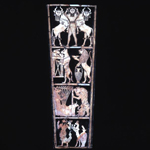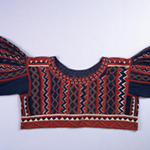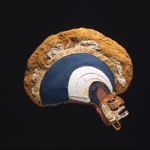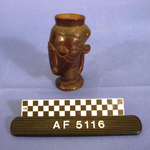Lyre Fragment: Plaque [Object of the Day #105]
By: Alyssa Kaminski
This Fragment was originally found as the front plaque of The Bull Headed Lyre (object #B17694B). The plaque is broken into four panels that tell the story of royalty’s control over nature, funerary ritual, and entry into the underworld. The top panel depicts a nude figure wrestling with two human-headed bulls. This image represents a […]
Women’s Blouse [Object of the Day #104]
By: admin
This colorful blouse is part of a traditional women’s costume in the province of Bukidnon in northern Mindanao (Philippine Islands). It is made up of strips of dark blue and red cotton cloth, with appliqued and embroidered zigzag and chain designs in red, blue and white. It slips over the head, and is very short, […]
Royal Shawabti [Object of the Day #103]
By: Josef Wegner
Shabtis are mummiform funerary figurines buried in tombs to assist the deceased in the afterlife. Early ones appeared first around 2000 BCE during Egypt’s Middle Kingdom and then became very popular in later periods. They occur in a wide range of quality: from crude mud versions to elaborate ones in fine materials for elite and […]
Helmet Mask [Object of the Day #101]
By: admin
This type of helmet mask (tatanua) is worn by male dancers in large, multi-village funerary celebrations in central and northern New Ireland (Papua New Guinea). It features a large, arching crest of reddish brown plant fiber and sides decorated with red and blue trade cloth and feathers. The wood face, with straight open mouth and […]
Taizong Horses [Object of the Day #100]
By: Xiuqin Zhou
The six stone horse reliefs, known in Chinese as “Zhaoling Liujun” 昭陵六骏 (the six stone horses of Zhao Mausoleum), were commissioned by Emperor Taizong of the Tang dynasty 唐太宗 (r. 627-649) in 636 CE and presumably completed in 649 CE, the time of his death. The realistic depiction and exquisite carving techniques of these stone […]
Gospel of Saint Matthew [Object of the Day #99]
By: Jennifer Houser Wegner
This papyrus fragment was discovered by Grenfell and Hunt (of the Egyptian Exploration Society) at the site of Oxyrhynchus in 1897 at the beginning of several seasons of excavations that took place at the site from 1896-1907. The name Oxyrhynchus (meaning “bent-nose”) comes from a type of fish that was sacred to the ancient Egyptians. […]
Carved Wooden Cup [Object of the Day #98]
By: Alyssa Kaminski
This anthropomorphic cup is carved from wood by the culture of Bushongo. It was made in Africa in the Kasai District. The cup is in the shape of a human head with an elongated neck featuring a choker. The face has decorative markings leading down from the eyes. On the back of neck a […]







